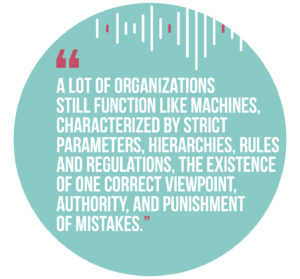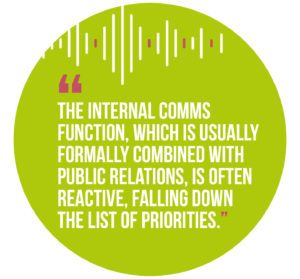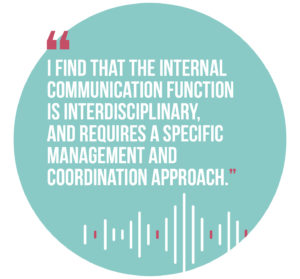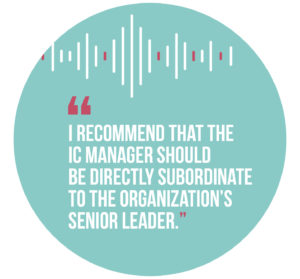
Internal communications strategist Ieva Zaumane joins us from Latvia to share her thoughts on where IC belongs within organisations, and how it should be managed to ensure maximum impact and effectiveness…
When my internal dialogue on the meaning of working in public relations began about 10 years ago, and the revelation that it is internal communication which determines how an organization’s reputation is shaped in the external environment came to light, it became very clear to me how internal communication should be practiced and managed in the workplace.
I was working in PR and overseeing the Communications Unit for my company at the time, and firmly believed that the implementation of internal communication was my responsibility.
Now, 10 years later, I am no longer sure that the strategic management of internal communication falls within the remit of the public relations department.
 Here’s what I’ve discovered, through talking to executives, academic research and studying companies, practices, and theories: even though the internet is full of information and resources on IC best practices, many organizations in Latvia and elsewhere are still struggling to create meaningful internal communications for their employees.
Here’s what I’ve discovered, through talking to executives, academic research and studying companies, practices, and theories: even though the internet is full of information and resources on IC best practices, many organizations in Latvia and elsewhere are still struggling to create meaningful internal communications for their employees.
And so, here is the question I raised for my doctoral thesis: how is this possible, especially in an era of widespread information where communication managers are incredibly knowledgeable and skilled, and have all this information constantly at their fingertips?
This then led me to wonder: if the problem is not the availability of information and knowledge, perhaps I need to look deeper?
And of course, I started looking right away!
In this blog, I would like to share some of the lessons I’ve learnt along the way, which have allowed me to build an understanding of why internal communication within many organizations in Latvia and elsewhere is being implemented at a reactive level, rather than through a strategic, proactive approach.
Before we dive in, did you know you could be receiving an exciting dollop of IC inspiration like this every week?
Subscribe to our Friday Ketchup to get handpicked internal comms and employee engagement insights, facts, and ideas squeezed straight into your inbox, every Friday.
1. ‘Machine’ vs ‘living’ organizations
James E. Grunig developed Excellence Theory in the early 90s, describing the work of a distinguished comms department and an ideal communication model which creates meaningful relationships between the organization and its internal and external stakeholders.
For a third decade, communication professionals have been pursuing this approach of excellence by advocating symmetry in the relationship between management and employees.
The famous concept of win-win is the result of Grunig’s symmetric two-way communication model, in which employees are equal partners in dialogue with management.
For many years, I was also convinced that this was the only and right solution for building internal communications within organizations.
But by deepening my knowledge of organizational systems following studying with Berth Helinger’s school and researching Systems theory, I came to the conclusion that I had been operating under an illusion of what organizations need, rather than the reality.
We hear about the concept of “living organizations” (where there is self-regulation; ability to learn; no hierarchies; several different viewpoints and high potential for cooperation) more frequently nowadays.
 However, the challenge is that in the process of relaunching this ideal, communicators, consultants and advisers forget that many organizations still function like machines (characterized by strict parameters; hierarchies; rules; searches for perpetrators; the existence of one correct viewpoint; authority and fear of mistakes).
However, the challenge is that in the process of relaunching this ideal, communicators, consultants and advisers forget that many organizations still function like machines (characterized by strict parameters; hierarchies; rules; searches for perpetrators; the existence of one correct viewpoint; authority and fear of mistakes).
Moreover, these types of organizations not only exist, but they also have the right to operate as they do. Therefore, I believe that this is the time to recognize that there are organizations which will always remain in ‘machine’ form, and that in such an environment it is just not possible to force leaders to adopt a symmetric internal communications approach.
This, in turn, means that there cannot be a sign of equality between strategic internal communications and two-way symmetric communication, as we still want to highlight.
2. Internal communications is a function, and should be managed as such
For decades, the question has been on the agenda of internal comms researchers and practitioners of who should be responsible for internal communication within organizations.
Until now, there was no common view and practice, but this uncertainty unfortunately leads to covert conflicts and unnecessary competition between communication, marketing, and HR functions.
In addition, over time, I have come to understand the fundamental difference between “being responsible for” and “managing.” While we are talking about responsibility, it is easy to want to pull the trigger on our own, because the concept of responsibility may not include movement, or concrete action.
 But when the questions of “Who will lead on this?” and “How will you manage this?” arise, the role of the manager of internal communications takes on a whole new meaning.
But when the questions of “Who will lead on this?” and “How will you manage this?” arise, the role of the manager of internal communications takes on a whole new meaning.
Internal communication is essentially the same function as personnel, marketing or external communication management. These three functions usually have a clear owner, but internal communication, which is usually formally combined with public relations, is often reactive, falling down the list of priorities.
There are even cases where internal communication does not exist as a deliberate and recognized function at all in organizations. And if it doesn’t exist, how can it be managed?
In addition, from a systemic point of view, each function must have a defined place and a clear delegation in order to be able to fulfill its unique mission. Moreover, if there is no clear place for a function within the organization, there is a higher risk of conflict, over both the resultant outcomes, and who will be its main driver.
However, the senior management team must clearly identify its own place within the successful implementation of internal communications, before any decisions can be made as to how the function will be run.
Because senior leaders need to recognize their role and responsibility in shaping the IC function in order for it to be successful, it must be made clear that the level of strategic internal communication depends on input and management from the C-Suite.
3. Internal communications needs a permanent home
Senior leaders and managers need to know how to give formal and informal feedback.
To start a conversation about where internal communication needs to be situated within an organization, I propose a self-developed mind map that reflects all the knowledge and competencies that I believe a professional who manages strategic internal communication should have.
Using this mind map, you can see what exactly and how much needs to be recognized and understood by the professional to whom the function is delegated.
 Assuming that only rarely can just one person have such extensive capabilities, I find that the internal communication function is interdisciplinary, and requires a specific management and coordination approach.
Assuming that only rarely can just one person have such extensive capabilities, I find that the internal communication function is interdisciplinary, and requires a specific management and coordination approach.
Having made observations in my own country of Latvia and elsewhere, I can conclude when the management of this function is undertaken by public relations, marketing and HR, as is historically typical, this may undermine its influence within the organization. This is also the main conclusion of researchers who are still trying to find the right place for internal communication within a business.
For example, if internal communication is managed by the head of PR, there is a risk that external-communication priorities will overshadow it.
Unfortunately, when it comes to Latvian public relations, primary KPIs are still publicity, awareness and external reputation. Consequently, internal communication remains stuck on a reactive and tactical level.
On the other hand, if internal communication becomes HR’s responsibility, it may be warped into an internal PR instrument for communication around employee bonuses and other basic personnel matters.
This is because, as the practice suggests, there are few organizations where HR managers are prepared to put much thought into the internal communications strategy.
Finally, putting internal communications in the hands of marketing managers may lead to it becoming simply an internal marketing tool, rather than a function dedicated to inspiring and engaging employees.
It should be noted that all these are acceptable to a degree, but internal communications only becomes strategic when the organization is clearly aware of what the function can achieve, and what its nature will be if it is managed by each of these different but related departments.
Greater awareness also means that senior management clearly understand what can and cannot be expected from the leader of this function, in every situation.
4. Taking internal communications to the next level with Symphonic Management
Since there are so many discussions and opposing opinions about where IC should sit within an organization’s structure which do not create feasible solutions, I have arrived at a concept that could give positive input to machine-type organizations and help living organizations to optimize their internal communications.
A 2018 study by Deloitte suggests that corporate senior executives need to get out of their functional “silos” and start working together.
Putting this into practice is likely hard to imagine for leaders of companies who for decades have each managed their individual functions in a restricted, exclusive capacity.
 This idea is rooted in two principles: that deep functional expertise is still very important, but also that interdisciplinary cooperation makes organizations faster, more efficient and more successful.
This idea is rooted in two principles: that deep functional expertise is still very important, but also that interdisciplinary cooperation makes organizations faster, more efficient and more successful.
This can be explained by the fact that a large number of issues can no longer be resolved within a single functional unit and, in order to ensure rapid decision-making, management teams should work together as a whole, which also requires employees to recognize a common goal and to invest their time and resources in the implementation, within their own unique competences.
It is this approach that I believe is the most effective solution in the management of internal communication at the present time. It is obvious that one person within the organization must be an expert who understands how to build and manage strategic internal communication, but the role of an interdisciplinary team is equally as important.
How does Symphony Internal Communications Control work in practice?
The organization must nominate the head of internal communication – a person who acutely understands the business, strategy, communication, employees, culture and change, and who is confident and skilled enough to make an influential impact.
 I recommend that this manager should be directly subordinate to the organization’s senior leader. There are two main reasons for this.
I recommend that this manager should be directly subordinate to the organization’s senior leader. There are two main reasons for this.
First, the head of internal communication would be in regular contact with the C-Suite, providing them with access to essential strategic information and direction. Secondly, power games between public relations, personnel and marketing managers over who ‘owns’ internal communications would be eliminated, because the new IC manager could connect them all with a common, interrelated purpose.
The head of internal communication should be empowered to lead interdisciplinary groups within the organization. The organization’s senior leader would need to legitimize this manager’s status and give a clear signal to the whole workforce as to the kind of role they would perform within the organization.
Specifically, this role would principally involve leading the IC team, while also being the primary planner, developer, implementer and controller of the internal communications strategy.
But even more important, is the ability to decide on the objectives, strategy, and methods of implementation collaboratively and collectively with their team.
But, it’s important that the organization’s senior leader is also involved with the internal communications team. They need to accept, ideally, that internal communication is fundamentally their function, and that the IC team is there to simply implement it.
Ultimately, when all’s said and done, it all depends on the senior leader.
Because in internal communications, everything is determined by what they want to communicate, and how they present themselves to employees – including their attitude, how they personally communicate, and how they uphold the organization’s values and culture on a daily basis.

Meet the author

Ieva Zaumane
Ieva Zaumane is a business trainer and strategic consultant on internal communications and employee engagement, based in Latvia. She has more than 17 years of experience in strategic communication and team management, and is currently working on her Ph.D. thesis on internal communication. She enjoys sharing her practical knowledge and experiences with different audiences – both academic and practitioner – and firmly believes that even the smallest organizations can afford and are able to implement the strategic internal communications to maximise their productivity and success.
Looking for some superb extra support with your internal communications?
We’ve got you covered. Our specialist team of IC strategists, copywriters, designers and OD experts can create bespoke communications campaigns that will make your employees buzz with productive brilliance. Get in touch today to find out what we can do for you!
Got a brilliant idea you simply can’t keep to yourself?
We’re always looking for fresh faces to help us further the IC conversation by writing guest articles for our blog. If you want to make your voice heard on internal comms, employee engagement, change management or leadership development, we’d love it if you got in touch!












